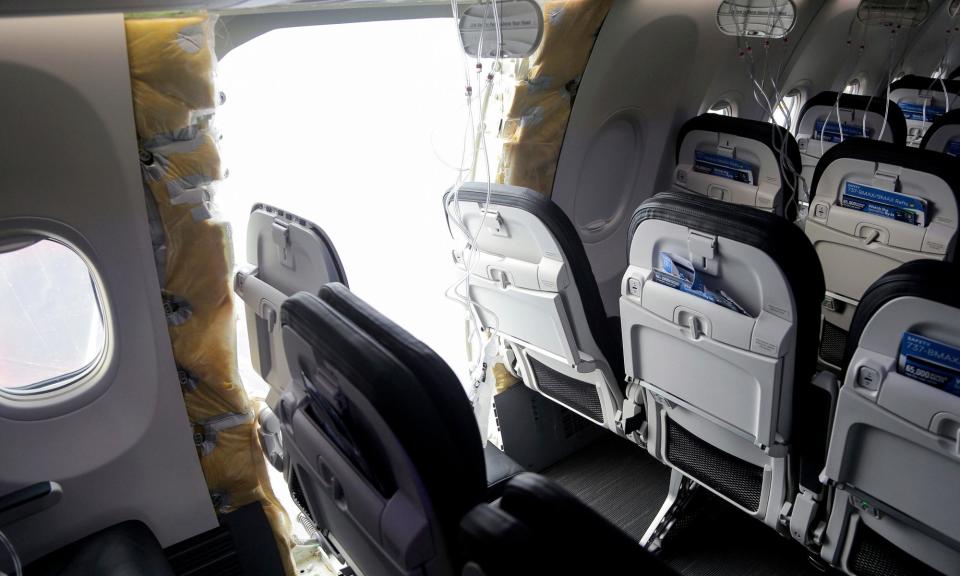Four bolts appeared to be missing from Boeing panel that blew off, regulator says

A cabin panel that blew off a brand-new Boeing 737 Max 9 jet mid-flight appeared to be missing four key bolts, according to an initial report by the US safety regulator.
The bolts meant to hold the door plug in place were absent, the National Transportation Safety Board (NTSB) said. It released photographic evidence alongside the preliminary findings of its investigation on Tuesday.
Boeing has tried to reassure regulators, airlines and passengers following the dramatic incident during an Alaska Airlines flight, which prompted 171 Max 9 jets to be grounded for several weeks.
The NTSB said the four bolts were removed while workers repaired damaged rivets last year at Boeing’s facility in Renton, Washington. A photo taken during the work shows at least three of the bolts had not been replaced, with the location of the fourth obscured.
The agency is still investigating “what manufacturing documents were used to authorize the opening and closing” of the plug “during the rivet rework”, according to its report.
In a statement, Boeing boss Dave Calhoun said: “Whatever final conclusions are reached, Boeing is accountable for what happened. An event like this must not happen on an airplane that leaves our factory.
“We simply must do better for our customers and their passengers. We are implementing a comprehensive plan to strengthen quality and the confidence of our stakeholders. It will take significant, demonstrated action and transparency at every turn – and that is where we are squarely focused.”
While Max 9 planes have been allowed to return to service following inspections, the Federal Aviation Administration (FAA), America’s top aviation watchdog, has said it will not grant any production expansion of the wider Max program for now. On Monday the agency said 94% of the affected jets have now returned to the skies.
Hours before the NTSB released its report, the FAA pledged to scrutinize “unacceptable” quality issues at Boeing and use the “full extent” of its authority to hold the aircraft maker accountable for failures.
Related: Boeing may delay more 737 Max deliveries after incorrectly drilled holes found
A mid-flight panel blowout on a brand-new 737 Max 9 plane last month sparked a crisis for Boeing, its manufacturer, and raised questions about the FAA’s supervision of the industry.
Mike Whitaker, the new head of the FAA, stressed on Tuesday that the agency was “aggressively” expanding its oversight of Boeing’s production line and increasing scrutiny at the company’s manufacturing facilities.
The FAA ordered a “thorough” program of inspections and maintenance of Max 9 jets in the wake of the blowout, Whitaker stressed during a congressional grilling. “Our findings during inspections of those aircraft showed that the quality system issues at Boeing were unacceptable and require further scrutiny.”
Appearing before the House subcommittee on aviation, Whitaker assured lawmakers that “all options” remain “on the table” for improving safety on the Boeing production line.
The FAA is “aggressively expanding oversight of new aircraft with increased floor presence at all Boeing facilities”, he told the hearing, and “closely monitoring data to identify and mitigate significant safety trends and risks” in the system.
“Let me stress: we will follow the data and take appropriate and necessary action,” Whitaker added. “The safety of the flying public will continue to inform our decision-making.”

 Yahoo Finance
Yahoo Finance 